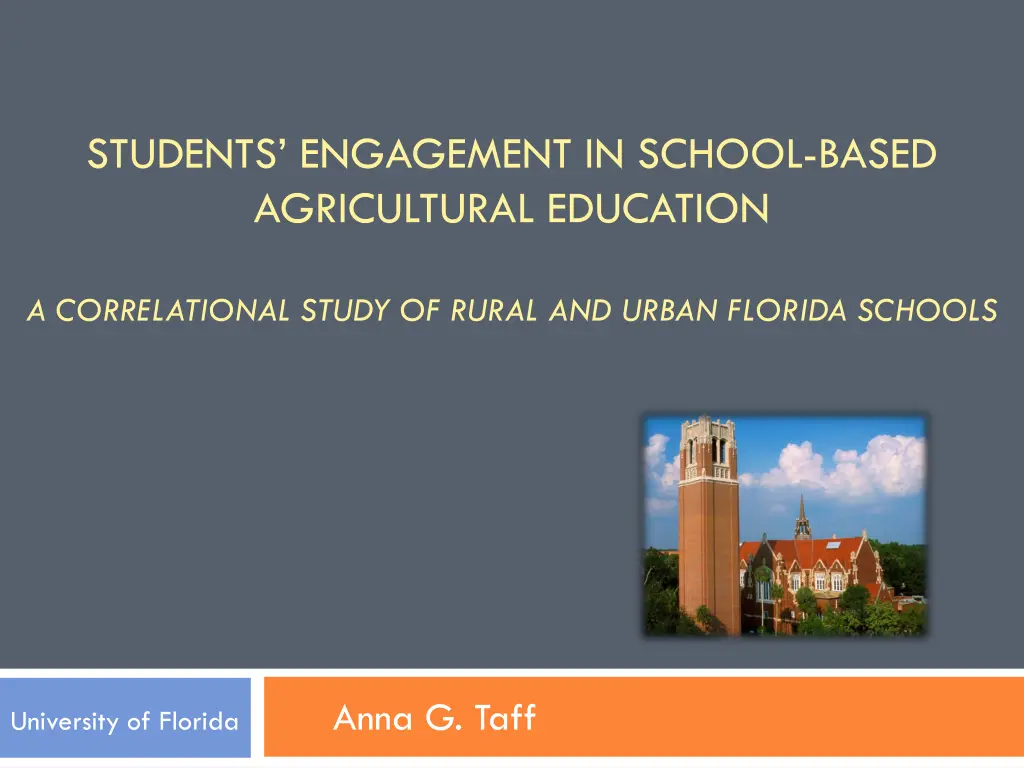
Students Engagement in School-Based Agricultural Education: Correlational Study of Florida Schools
Explore the engagement levels of students in rural and urban School-Based Agricultural Education programs in Florida. The study aims to compare engagement between boys in rural and urban settings, and examine the relationship between student engagement and psychological and cognitive factors. The research design involves a purposive survey design using the Student Engagement Instrument.
Download Presentation

Please find below an Image/Link to download the presentation.
The content on the website is provided AS IS for your information and personal use only. It may not be sold, licensed, or shared on other websites without obtaining consent from the author. If you encounter any issues during the download, it is possible that the publisher has removed the file from their server.
You are allowed to download the files provided on this website for personal or commercial use, subject to the condition that they are used lawfully. All files are the property of their respective owners.
The content on the website is provided AS IS for your information and personal use only. It may not be sold, licensed, or shared on other websites without obtaining consent from the author.
E N D
Presentation Transcript
STUDENTS ENGAGEMENT IN SCHOOL-BASED AGRICULTURAL EDUCATION A CORRELATIONAL STUDY OF RURAL AND URBAN FLORIDA SCHOOLS University of Florida Anna G. Taff
Need for the study Boys performing less academically in secondary school; less so than their female counterparts. (Houtte, 2004) More girls than boys on average in FFA leadership positions (Ricketts, Osborne, & Rudd, 2004) Girls had higher scores for engagement, and scored higher in academic performance than boys by their teachers (Lam et al., 2012)
Literature Review Student engagement is influenced heavily by motivation. According to Connell & Wellborn (1991), Engagement operates within a motivational framework (Appleton 2012, pg. 726). Psychological engagement which is influenced by things students value, such as relationships and sense of belonging (Appleton, 2012). Cognitive engagement incorporates the students value they place on the relevance of learning, schoolwork, goals, and future endeavors (Appleton, 2012). Four types of extrinsic motivation move along a continuum; External, Introjected, Identified, and Integrated (Deci, Vallerand, Pelletier, Ryan, 1991).
Objectives 1. Ascertain the level of engagement of students in rural and urban SBAE programs. 1. Compare and contrast the level of student engagement between boys in rural SBAE programs and boys in urban SBAE programs. 1. Examine the relationship between level of student engagement and psychological and cognitive engagement.
Population & Sample 6 Florida School-Based Agriculture Education Programs 3 Rural Programs 3 Urban Programs 172 Agriscience students Grades 10th, 11th, 12th
Research Design & Methods Purposive Survey Design Student Engagement Instrument SEI (Appleton et. al., 2006)
Description of Respondents Rural v. Urban Grade Level Rural Urban 9th 10th 11th 26.2 30.8 Age 14 38.4 61.6 15 16 43 17 Semesters 18 Gender 19 0 1 2 Male 47.7 3 4 5 52.3 Female 6 7 8
Findings - Objective 1 1. Ascertain the level of engagement of students in rural and urban SBAE programs. Rural Students A: 2.72 Teacher and Student Relationship B: 2.95 - Peer Support for Learning C: 3.58 Family Support for Learning D: 2.87 Control/Relevance of School Work E: 3.56 Future Aspirations and Goals F: 1.64 Extrinsic Motivation Urban Students A: 2.69 Teacher and Student Relationship B: 3.01- Peer Support for Learning C: 3.36 Family Support for Learning D: 2.80 Control/Relevance of School Work E: 3.55 Future Aspirations and Goals F: 1.68 Extrinsic Motivation
Findings Objective 2 Compare and contrast the level of student engagement between boys in rural SBAE programs and boys in urban SBAE programs. 2. According to Davis (1971), low levels of correlation (.10 - .29) between; Male vs. Female and Rural vs. Urban Male vs. Female and Number of Semesters Male vs. Female and Future Aspirations and Goals Male Vs. Female and Extrinsic Motivation Very High Level of correlation (.70 - .99) between; Relationship between Rural students with Control/Relevance of School and Future Aspirations and Goals
All Respondents Mean Scores Males A: 2.66 Teacher and Student Relationship B: 3.04 - Peer Support for Learning C: 3.45 Family Support for Learning D: 2.47 Control/Relevance of School Work E: 3.43 Future Aspirations and Goals F: 1.81 Extrinsic Motivation Females A: 2.75 Teacher and Student Relationship B: 2.94 - Peer Support for Learning C: 3.43 Family Support for Learning D: 2.91 Control/Relevance of School Work E: 3.67 Future Aspirations and Goals F: 1.54 Extrinsic Motivation
According to Davis (1971), low levels of correlation (.10 - .29) between; Male vs. Female and Rural vs. Urban Male vs. Female and Number of Semesters Male vs. Female and Future Aspirations and Goals Male Vs. Female and Extrinsic Motivation Very High Level of correlation (.70 - .99) between; Relationship between Rural students with Control/Relevance of School and Future Aspirations and Goals
